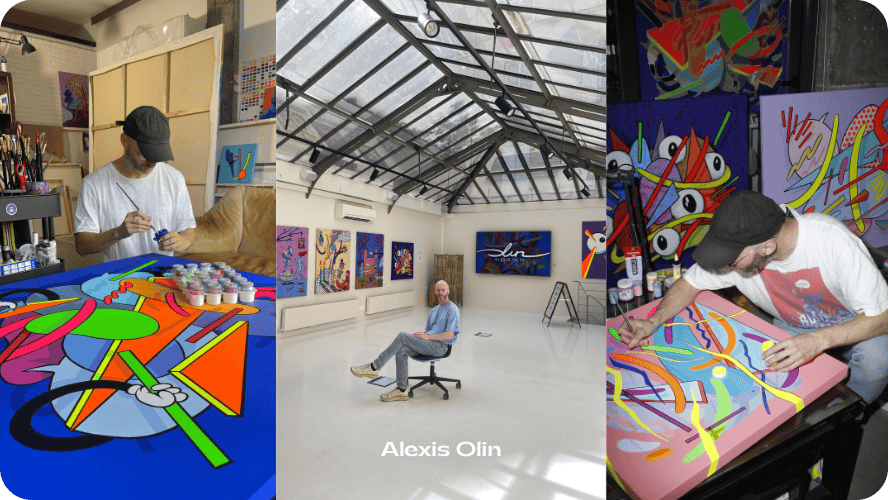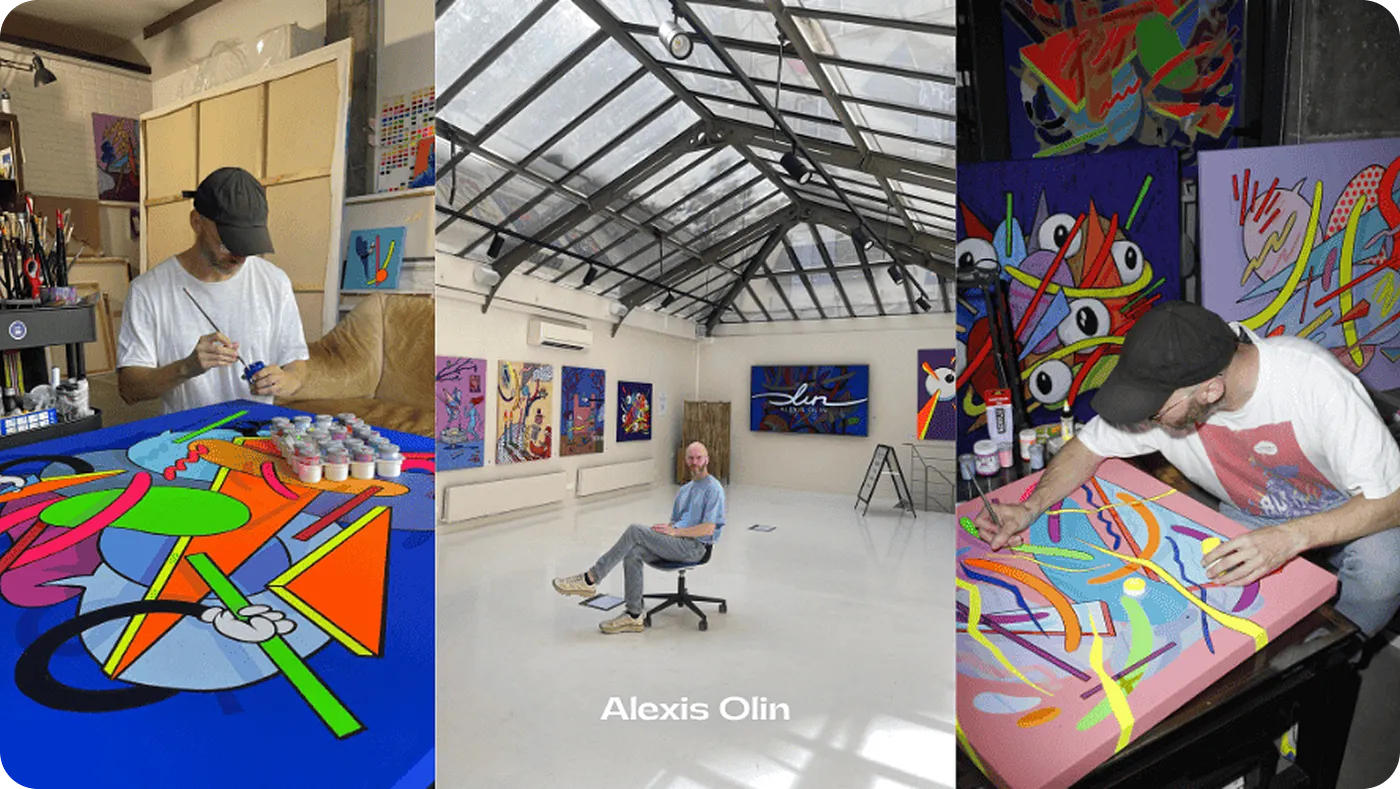
October 23, 2025
Rabbits, Rituals, and Radiance
Inside the vivid, disciplined world of artist Alexis Olin, where comics, color, and creatures converge.
The first time we came across Alexis Olin's work, it was the summer of 2021. He had just debuted Meditation Rabbit, a rabbit dressed in something punk, a little cute, and strangely serene. In the description, he noted it was inspired by anime and manga.
But Alexis's work quickly revealed itself as more than just "comics." Over the years, his art has felt like it belongs everywhere at once, on a living room wall, tucked inside a comic panel, resting on a coffee table, or projected in a digital gallery at the Louvre. That range is very Alexis.
Now based in Barcelona, with roots in Kyiv, Alexis moves between comics, painting, digital art, and textiles, creating a world that is both accessible and mythic. His rabbits, cats, and spirits are never simply animals. They are characters, stand-ins for human moods, shaped by history, mythology, and ritual. In our conversation, he shared how comics changed his visual language, why animals remain at the center of his practice, and how discipline keeps him grounded in a noisy, distracted world.
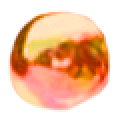


From underground comics to the ninth art
I've been drawing since I was a kid in school. I remember having a friend in class who also drew pretty well, and we would take grid notebooks and create comics featuring imaginary adventures of made-up characters. At the time, whenever I had the chance, I would buy comics that were rare finds, especially with translations.
Then, in my first year at university, I drew a comic and showed it to a magazine, and they published it. I had no idea how to properly draw comics, how to design speech bubbles, or how to arrange the frames. So you could call it underground comics, really. In my second year, I ended up in France, near Angoulême, a city that hosts the International Comics Festival and is home to the National Comics Center. The following year, the trip organizer invited me again, this time during the actual festival, and I think that was a turning point. At that moment, everything seemed to revolve around the art of comics.
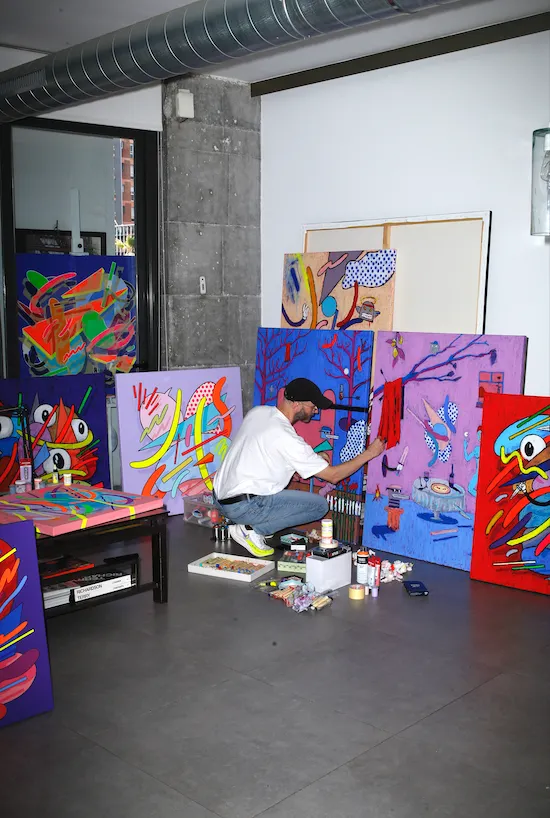
By the way, in France, comic art is considered the "ninth art." That's why we called it K9 magazine, the "K" is a Cyrillic nod to the Latin "C" from "Comics." In the ninth art, there were countless characters and universes, different storylines, comics with words, comics without words, colored, black and white, adult, children's; it was like a vast library of ideas. I could look at someone's work and then create something of my own that might be completely different. For me, the impulse that inspires is what matters, and comics were the first to give me that spark, which later helped shape the visual language of my painting.
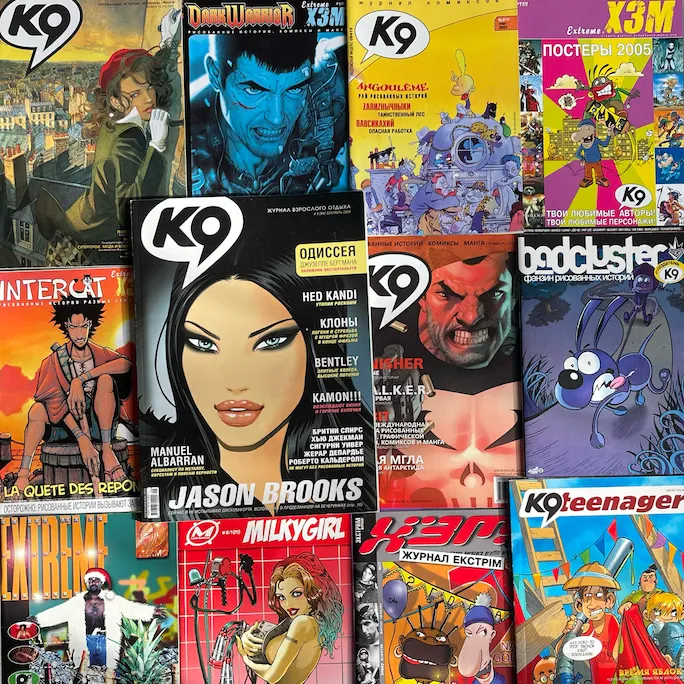
Why rabbits, and why mythology matters
I often ask myself why one of my most frequently used characters is a rabbit, why not a cat or a dog? It's a tricky question. I think I just really like how they look visually, the upright ears and all, but then I fill the character with my own meaning. So it's not the rabbit as we know it. He can be aggressive, angry. He has a personality. He has style.
As for the mythological side, I'm very interested in history, especially alternative history. For me, ancient Egypt and the Mayan civilization are like hypnosis. I can study them for hours and days. That's a major source of inspiration for me, and I transform and channel that into my characters. I sometimes give my rabbits or other animal characters human traits. I find it fascinating when the body of the character becomes an avatar—you expect the behavior of a rabbit, for example, but in reality, it’s only a rabbit on the outside; inside, it behaves like a human being. The way animal images can shift or transform reminds me of my desire to convey emotion. If I feel that a certain image in a painting needs to be pushed into abstraction, I'll do it.
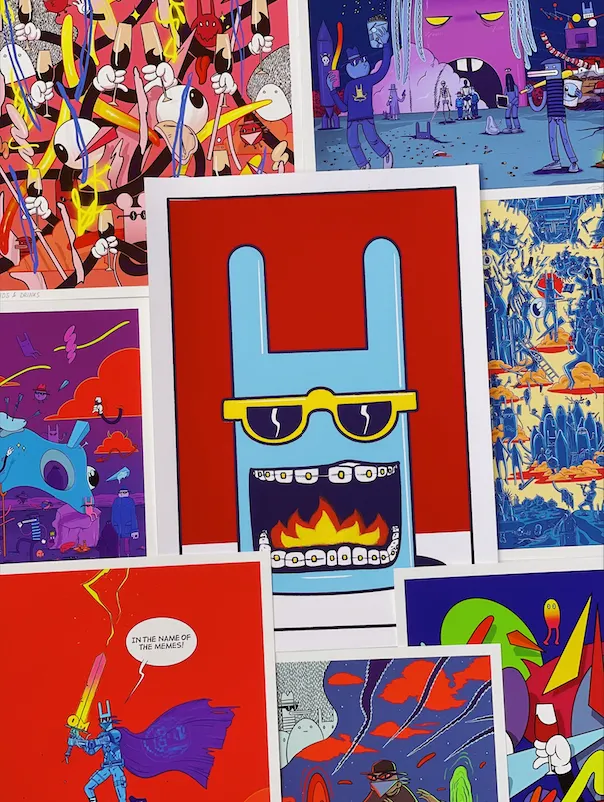
Barcelona, Paris, and the colors of cities
Right now I'm in Barcelona. But when I had an exhibition in May this year, I spent a month in Paris and realized that the art scene there offers more opportunities to connect. Barcelona is great when your process is already established, when you have collectors ordering paintings in advance, and prints are being produced; in this case, you don't really need to search for new galleries or connections. But now, after four years, I've returned to the physical world, and that's important to me.
The influence of the city is undeniable. A professor once told me that in big cities, colors tend to be more intense, and in cities like Tokyo, Shanghai, or Chengdu, they're turned up to the maximum, because many people, without realizing it, live in a depressed or anxious state, and it's the bright colors that help pull them out. You're walking down the street and suddenly there's a bright glowing sign that grabs your attention. But when you're in nature, outside the city, your inner state stabilizes, and your palette starts filling with more pastel, classical tones, pushing away the aggressive ones.

The Result of Habits and habits as creative engines
The exhibition of The Result of Habits took place on two floors in central Paris, in the Marais district at Artverse Paris Gallery.
” Habits are a very important and meaningful topic for me. The world is speeding up in every sense, and in my view, only through daily rituals can you remain competitive. That's largely the key to keeping up with today's pace of life.
These days, discipline plays a more crucial role than inspiration. Maybe before, you could come to the studio, sit by the canvas, drink tea or beer, read a bit, look out the window, scroll through something, then go home without doing anything because inspiration didn't come, and just try again tomorrow. Now, with social media and the enormous number of distractions on your phone, from messengers to YouTube, Netflix, and so on, there's a 24/7 fight for your attention. In this kind of flow, waiting for inspiration is really hard.
I just sit down and work, and inspiration comes along the way—it's a product of discipline and persistent effort. For example, with the exhibition, to get those precise lines, I trained daily. Honestly, I think I've been living by a planner for the past 15 years. I need to see my entire week laid out. Each day is filled about 70 percent with fixed tasks, and 30 percent is left for flexible tasks or rescheduling. On one hand, it might seem robotic, but I disagree. These are my clearly defined goals and desires, and without them, there are just too many distractions. For example, you're drawing, and then a friend texts you that he watched the new episode of a show, so you drop everything and go watch it. Or you're doing something, and a friend calls you to go for a walk—you go. Then at the end of the day, you're standing by the canvas or iPad, wondering where the day went and why you didn't get anything done.
Choosing the medium: canvas, digital, film
Until 2021, I was partially in the physical world and partially digital. But in 2021, I completely switched to digital / NFT world. Only at the end of last year did I start to realize that the market is extremely volatile, and as you know, it's entirely tied to the crypto market. I came to understand that the physical world is still more stable, so I decided to return, and now I dedicate most of my time to physical work.
I'll also say that working with physical materials gives me more emotional return than waking up with sore eyes after a full day on the iPad. Film photography also holds some kind of magic for me. Digital photography is simple—you look at the screen and control everything. With film, I work manually and think through each setting, aperture, ISO, shutter speed, and then boom, there's magic. You still have to wait for developing and scanning. But it's true that now, I can use digital photography for faster results, because most of my time is spent on painting. Currently, my focus is on galleries with paintings, and I also want to pay more attention to installations and performances.
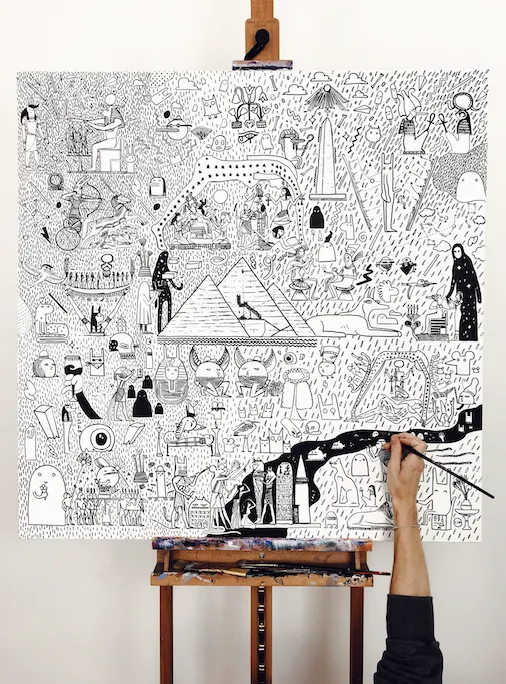
The one piece that I want people to check out
I'd recommend the works featured on SuperRare: Nephel's Dream, In The Name of Digital Renaissance, and The Dream World. They're all very detailed and open up my universe.
On the other hand, there's The Result of Habits, which will now primarily be presented in digital format. The collection has been included in a curated release on SuperRare. With the digital works, collectors also receive physical pieces, made of two parts—the first is acrylic on canvas, which I prepared for nearly a year, and the second uses techniques like oil pastel, spray paint, and oil. At this stage, I see myself continuing to work on this technique. I really enjoy it. One part of the collection is meditative, the other—expressive.
Building a universe of characters
I've always wanted to create a universe where all my works, including the abstract ones, have meaning and play a role. I even built an imaginary timeline where each collection is placed.
” This is a really interesting topic for me. As for the creatures, I already have many—from humans to rabbits, cats, dogs, mice, and spirits. I think that when the opportunity arises, I'll create a special comic that will act as a guide and an invitation to my world.
I study a lot, read, and watch content about contemporary art, and I study how galleries, art fairs, and museums relate to different forms of art—how they perceive abstraction, how they respond to neo-pop works with characters, and how performance or installation art is received. For some, if an artist is still working on canvas, it's not considered contemporary art - they see it as someone just trying to survive, to put it bluntly. But I want to build something within the framework of contemporary art, and I have ideas about how to do that. I'm currently looking for investment for my studio, which will be the first big step.
My girlfriend has been actively looking at teacup Maltipoos for the past two weeks. It looks like a comic character and might become a hero in one of my future works. Also, her sister has a Pomeranian, a charismatic little white dog. I even created a Rodeo page for him, where we posted his photos and updates daily, much like a Polaroid diary.
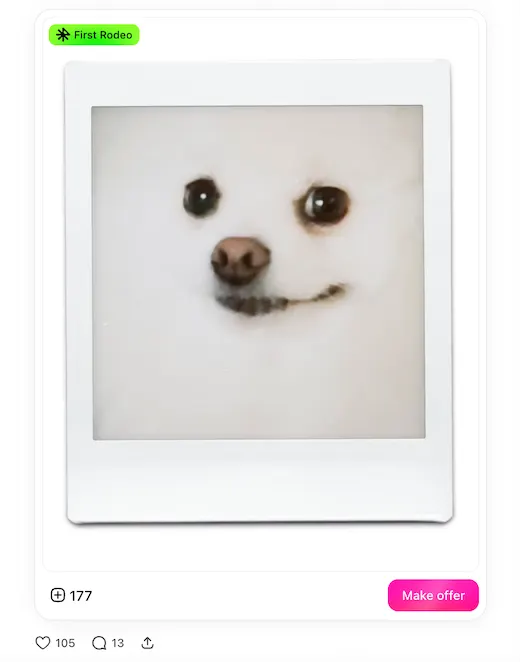
What's next: from SuperRare to Paris
Right now, the collection on SuperRare is especially important to me. If it goes as I envision, I would like to prepare works for their offline gallery next year, which fits perfectly with my concept.
I'm also participating in group exhibitions at LaPlatforma (Barcelona) and Lezar House Gallery (Barcelona). The next solo exhibition is planned in Paris, though I won't name the gallery just yet, as there will likely be two. In addition, I've started selling prints in two OMG BCN stores (Barcelona), which specialize in limited-edition prints and exclusive art-related merchandise.



We thank Alexis for sharing his story with us. You can follow him on X/Twitter and Instagram, and visit his website.



More stories
Furrend circle
Be the first one to hear about updates
